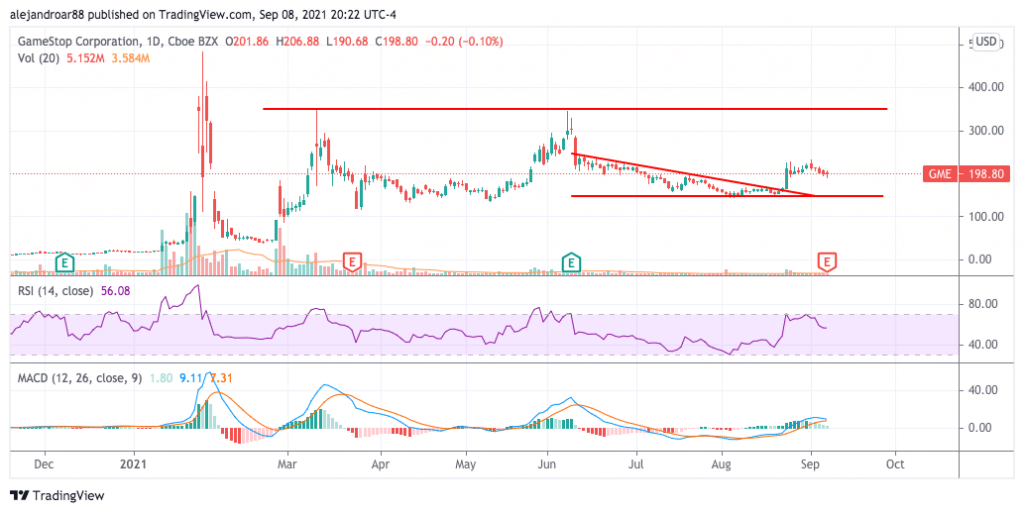GameStop Stock Down 8% – Time to Buy GME Stock?
Please note that we are not authorised to provide any investment advice. The content on this page is for information purposes only.
The price of GameStop stock is going down more than 8% in after-market stock trading action at $181 per share following the release of the company’s financial results covering the second quarter of 2021.
During the three months ended on 31 July, the video game retailer reported revenues of $1.2 billion resulting in a 25.3% jump compared to the same quarter a year ago at a time when pandemic-prompted store closures were hitting the retail sector hard. This top-line result exceeded the market’s consensus forecast as compiled by Capital IQ by around 5%.
Moreover, GameStop reported adjusted operating losses of $51.4 million, adjusted net losses of $55 million, and diluted adjusted losses per share of $0.76. All of these figures resulted in an improvement compared to the same period a year ago but losses per share were nearly 14% higher than the consensus estimate of $0.67. This might be the main reason why GameStop shares are diving in after-market action.
GameStop shares have already been down for three consecutive days before this report came out. Could this post-earnings drop accelerate the downtrend for this meme stock?
In the following article, I’ll take a closer look at the latest price action along with assessing the company’s fundamentals to outline possible post-earnings scenarios for GameStop stock.
67% of all retail investor accounts lose money when trading CFDs with this provider.
GameStop Stock – Technical Analysis

The price of GameStop stock broke above a descending triangle pattern back on 24 August during a high-volume trading session that saw nearly 13 million shares exchanging hands – a figure that exceeded the 10-day average by almost 4 times.
However, this break has not yet resulted in a sustained uptrend in the price of the meme stock as GameStop closed below the 24 August closing price of $210 on 3 September as positive momentum appears to have decelerated.
Meanwhile, if this after-market downtick spills over to the live session tomorrow as is, chances are that the stock may continue to dive until it retests the $150 level. This results in a 17% downside risk if the price opens tomorrow’s session at $181 (today’s after-market price).
Momentum readings appear to be reinforcing this bearish outlook as the MACD has almost made a cross below the signal line on the back of steadily decreasing histogram readings while the Relative Strength Index (RSI) has just come down from overbought levels. These two setups are signaling that the stock might be about to reverse its latest uptrend.
That said, GameStop (GME) is not the typical stock as retail traders have distorted the price action multiple times by squeezing short sellers. Therefore, even though the short-term outlook for GME stock might seem bearish, betting against this company can be a really bad idea if one considers the risk that another coordinated effort from the retail army could end up pumping the share price dramatically.
According to data from MarketBeat, short interest for GameStop stands at 12%, which is commonly considered a high percentage. However, since trading volumes have expanded significantly for the stock, it takes less time for short-sellers to cover their positions without influencing the price too much. At the moment, it may take from 3 to 5 days to fully cover that 12% exposure without severely affecting the price.
GameStop Stock – Fundamental Analysis
GameStop sales have been declining steadily since 2018, moving from $8.55 billion to $5.09 billion last year as big-box retailers and e-commerce giants like Amazon (AMZN) have aggressively expanded their presence in the video game market.
As a result, the feasibility of the company’s business model remains in question and this is reflected by three consecutive years of net losses that have been primarily caused by restructuring expenses and a sustained deterioration in the firm’s gross profit margins.
One positive thing about GameStop is that the company has taken advantage of this latest meme-stock craze to raise capital to pay off its long-term debt. In this latest quarterly report, GameStop’s management announced that the firm has no long-term debt aside from a small $47.5 million low-interest loan granted by the French government as part of its support to businesses during the pandemic.
Meanwhile, the company ended the period with total cash and equivalents of $1.72 billion. This war chest currently accounts for nearly 12% of the market capitalization of the firm.
Sadly, GameStop has not yet managed to swing to profitability and that factor may continue to weigh on the firm’s valuation moving forward – this is, of course, not an assessment that incorporates the possibility of another short-squeeze.
At its current market capitalization (ex. cash), the stock is trading at only 2.3 times its forecasted sales for the 2021 fiscal year as compiled by Koyfin.
On the positive side, the company has no debt and generates billions of dollars in sales every year. On the other hand, its business model might be dying in the hands of e-commerce giants and big-box retailers.
If one considers the value of the brand and the company’s revenue-generation capacity as GME’s key assets, the current multiple is not at all stretched and may even attract an acquirer who can take advantage of the firm’s robust network of physical stores.
However, as a standalone company, the multiple does seem high unless the management reaches its goal of turning around the business.






